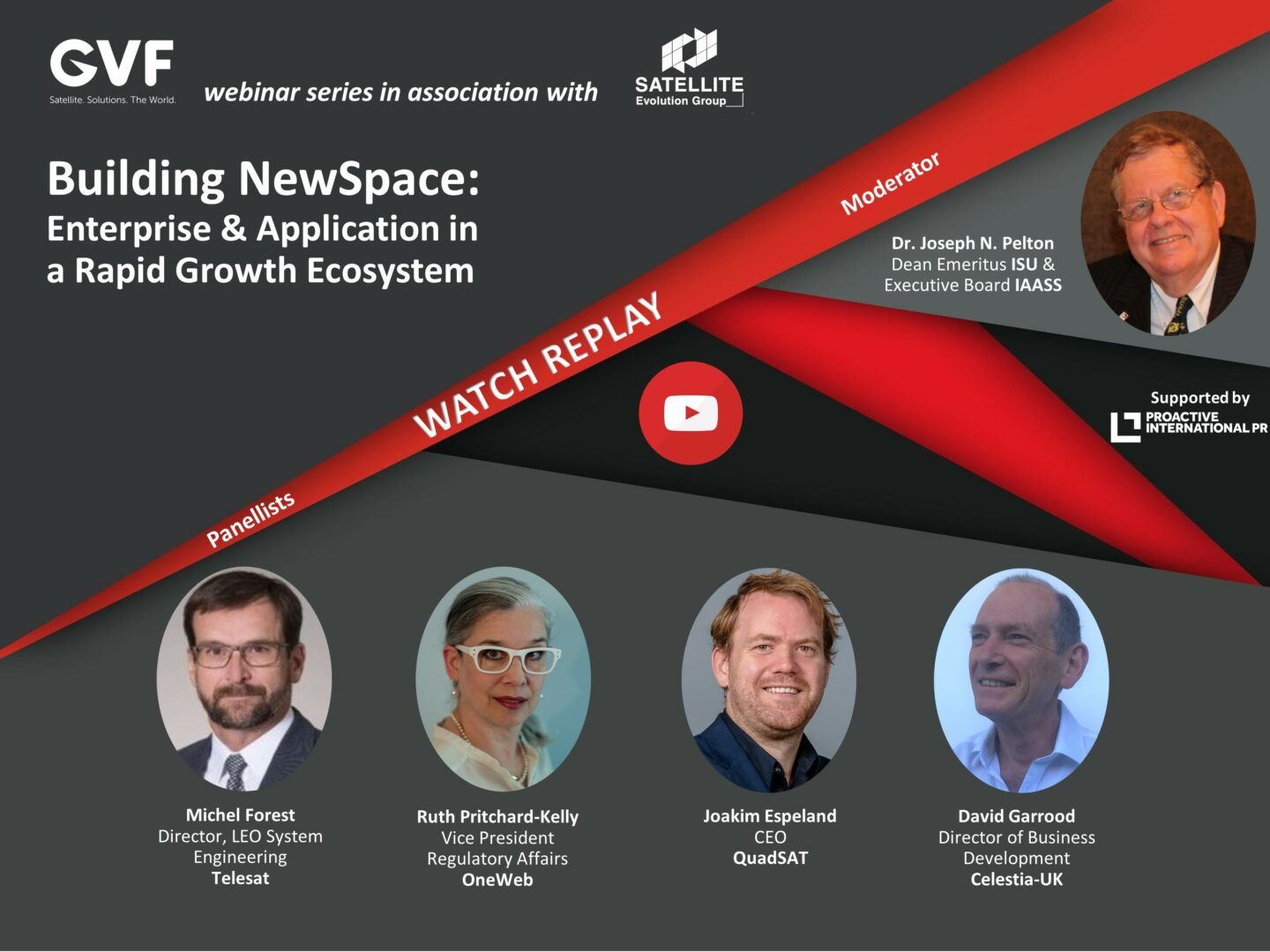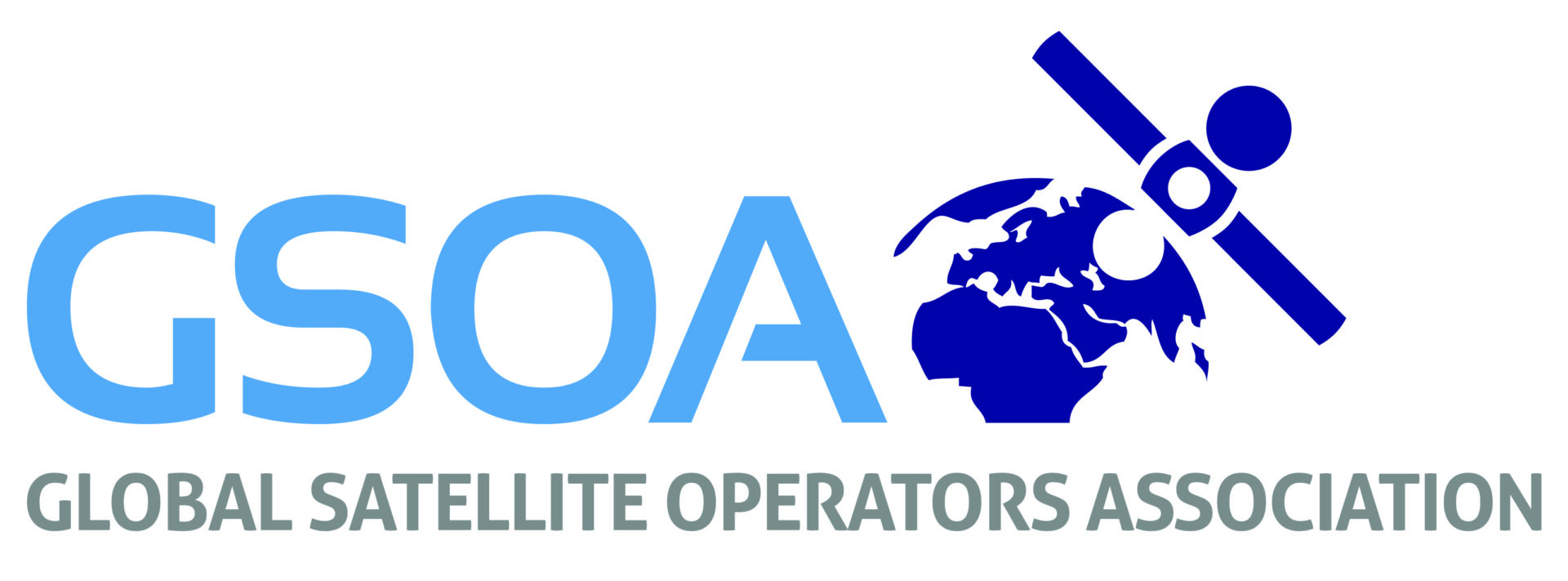Building NewSpace: Enterprise & Application in a Rapid Growth Ecosystem

With this webinar this year’s GVF-Satellite Evolution Webinar Series came to a close. With almost 200 attendees registered, and a 150-strong audience spanning 43 countries, a notable year came to a notable end, with an analysis of NewSpace, or Space 2.0 if you prefer. This “seismic shift in the global space industry”, to quote the webinar moderator, was the suitably expansive theme comprising the 15th discussion forum in a series which has proven to be an interesting and rewardingly successful response to the realities of the necessary limitations of pandemic travel restrictions.
Industry veteran Dr. Joseph N. Pelton, Dean Emeritus ISU & Executive Board IAASS, led this interesting discussion with Michel Forest, Director, LEO System Engineering, Telesat; Ruth Pritchard-Kelly, Vice President Regulatory Affairs, OneWeb; Joakim Espeland, CEO, QuadSAT; and David Garrood, Director of Business Development, Celestia-UK.
What is NewSpace? Where is it taking us? Whilst certainly ‘a rapid growth ecosystem’, as the webinar title indicates, the initial and general point of discussion leveraged the panel members expertise to identify just what NewSpace means to their businesses, and their respective industry segments, in terms of the pursuit of new technology, and of customers markets, and the nature of their strategic approach to the future.
NewSpace is often broadly described as a radical and rapid change away from the now decades-old historical model of the business of how we fund, design, build, launch, and operate satellites, and new ground segment infrastructure and technologies. NewSpace contemplates a private sector-led growth cycle which encompasses a space business incubation culture that comprises hundreds of new business units and entrepreneurial ventures serving evolving vertical market segments with new generations of orbital assets, we begin with a very grand and sweeping statement. This webinar investigated the concrete realities behind such words with a focus on “What drives NewSpace?”
In an animated dialogue the panellists explored such facets as entrepreneurial spirit, new design/manufacturing techniques, new sources of capital investment, identification of new user markets, and a few other necessary ingredients. The challenges of NewSpace were also examined. For example, the panellists with large NGSO constellations to deploy were asked to reflect on concerns regarding space debris and how to keep space safe, ensuring the avoidance of space collisions in LEO, and the ground segment panellists were challenged to explain how their companies meet the demands of manufacturing, testing, and calibrating electronically steerable antennas needed for LEO constellations whilst keeping costs down.
Earth sustainability issues were addressed too. Suggesting a cumulatively beneficial virtuous circle the key questions were, “Can new technology and services stimulated by NewSpace create new capabilities to monitor climate change, global pollution, police the oceans and other remote areas.” and “Do these new applications and space services at the same time help NewSpace ventures become more viable?”
Turning to ‘the money’, panellists were asked the closely inter-related questions, “Is it possible to generalise about how NewSpace is funded? Is it only VCs and Angels? Or can it be a simple as family and friends? What about Public-Private Partnerships, investment banks and IPOs? Does established industry, through acquisitions or other means, have an investment role with an eye to influencing, and deriving benefits from, the future?” The answers were fascinating.
Beyond the penetrating moderator questioning, a deeply engaged audience provided more material for discussion, which, if you missed it live, you can still gain from by tuning in to the video recording available here and on the GVF YouTube channel. You will find it 65-minutes very well invested.
Q & A continued….
The following questions were posed through the chat function during the panel. Thank you to our audience for taking an active part by asking questions, and to our panellists for their time to answer them after the webinar ended…
1. When comparing cost of launching of GEO vs LEO satellites that analysis should be done apples to apples 1000s LEO for same coverage and 5 x life so 5 launches needs be done during the time life of a GEO, does anybody in the panel comment?
Ruth Pritchard-Kelly: Not quite sure what the question really is asking, but here are some thoughts: Launch vehicles charge by weight and delivery orbit, so that would be same regardless of the final altitude (LEO, MEO, GEO) – no launch vehicle goes all the way to GEO, there is a transfer orbit. (Although some launchers can go directly to many of the lower orbits being used, so that may be allow for better pricing.) The coverage provided by the satellite is not related to the cost of the launch. Also, not sure why the questioner seems to think GEOs last 5 times as long as LEOs, as there are a breathtaking variety of LEOs being built. OW’s satellites, for example, are designed for minimum 7 years, more likely 10-plus years of life, while GEOs traditionally are designed for a minimum of 10 years, and usually manage 15-plus. So, possibly only twice as many launches – but the launch cost is not the sole reason to launch LEO rather than GEO. That’s like saying “well, “highways” need more lanes and are more expensive to build, so I’ll stick to using a bicycle on a dirt path.” Sometimes a dirt path for a single bicycle is all that’s needed, fine, but sometimes you need an 8-lane highway to allow thousands of vehicles to travel at very high speeds. You’d be willing to pay the extra for a freeway if that’s what’s needed.
2. Key in discussion so far is that it is acknowledged satellites are designed to “fail safe” and hence to best minimise risk of space debris or interference. True?
Ruth Pritchard-Kelly: Certainly true for OneWeb. We have a whole website devoted to our dedication to the sustainable use of outer space: www.responsible.space
3. Can OneWeb talk about which specific vertical markets they plan to address? Beyond consumer internet access.
Ruth Pritchard-Kelly: OneWeb’s polar orbits are ideal for providing 4G-quality broadband 24/7 to the Arctic by the end of 2021, which will be our first “vertical” (more a geographic region, in which we will address all interested verticals.) Of course, we already have 74 satellites in orbit – all fully-functional – with which we can provides demo’s and trials to all interested customers anywhere in the world. As the constellation grows, so will our 24/7 coverage. Existing user terminal technology, old-fashioned parabolic dishes, can provide cellular back-haul to the mobile network operators of the world, and direct service to anyone who doesn’t mind two parabolic antennas in their backyard! And let me tell you: farmers in the middle of nowhere, and villages in the far north of Canada are super excited to get one of these antenna sets, kitted out with wifi to reach to whole village. So while we hope the compact ESAs and sexy “pizza box” flat panels get developed soon, there’s no shortage of verticals willing to work with existing technology to get the high-speed broadband they crave.
4. Specially for Quadsat but others welcome to comment, do they see a potential C/I and noise floor raise with so many unregulated launches specially by individuals.
David Garrood: I think this is inevitable. The pressure to get low cost-user terminals forces down their off-axis gain and cross-polar discrimination performance and so they will generate more interference.
In the late 90’s, when earth terminal antennas were tightly regulated by the (GEO) satellite operators, the noise floors on GEO’s were 2-3 dB lower than they are now. The economic pressure to allow lower cost (and low performance) terminals was, in my view, the reason for this.
In mitigation however, there is a lot more sky when you have the whole hemisphere to use rather than just the GEO orbit, and the smaller beam coverages may make this manageable.
Expanding on the already answered questions during the live discussion:
- For NewSpace to succeed, we need a major advance in user equipment. Starlink has a good interim solution. Without this advance, we could have a repeat of business failure. Comments?
- It is said that User Terminal cost is concerning. I also hear that market will fill that gap. what trend do you see about cost reduction of User terminals? is this going to happen in the same time frame as LEO based service provider hope to generate revenue? will service providers (in LEO) such as OneWeb, Telesat and others willing to subsidize? if so, for how long?
Ruth Pritchard-Kelly: User Terminal uptake will surely follow the same path as other new electronics, with similar curves showing the price falling as the number of units demanded increases. The “early adopters” won’t likely be consumers to be honest – the first sales will be to user groups with a high demand for this technology and no alternative, such as governments and large mobility enterprises (shipping, aerospace). Those early adopters will start the demand curve, so that in time, as other user groups enter the market, the price for consumer retail sales will come down to an affordable price point. Some countries may provide tax breaks or subsidies either to their citizens or to telecom companies in the supply chain (last mile, middle mile, backhaul) to speed up delivery of space-based internet.
